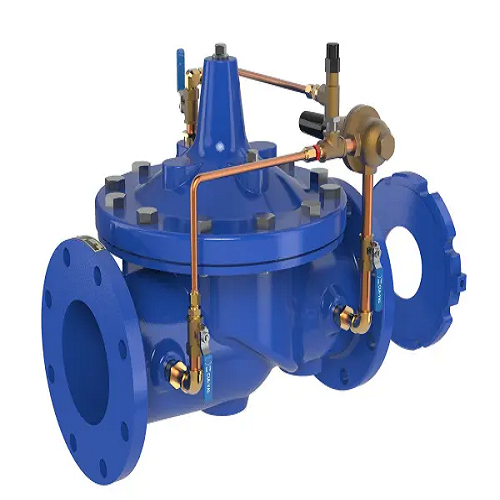
our category
FLOW REGULATING VALVE
Flow Regulating Valve: An Overview
A flow regulating valve is a type of control valve used to maintain a constant flow rate of a fluid (liquid or gas) in a system, regardless of fluctuations in pressure or system demand. These valves are crucial in applications where precise and consistent flow is required, ensuring that systems operate efficiently, safely, and within designated parameters. Flow regulating valves are commonly used in industries such as HVAC, chemical processing, water treatment, and irrigation systems.
Enquire Now
Key Features of Flow Regulating Valves:
- Constant Flow Control: The primary function of a flow regulating valve is to ensure that the flow rate remains constant, even when there are changes in system pressure or upstream/downstream conditions.
- Pressure Compensation: These valves are designed to automatically adjust their opening to compensate for pressure variations, maintaining the desired flow rate.
- Manual or Automatic Operation: Flow regulating valves can be manually adjusted or automatically controlled, depending on the specific needs of the system.
- Variety of Designs: Flow regulating valves come in several designs, including spring-loaded, diaphragm, and piston-operated valves, each serving different flow control applications.
How Flow Regulating Valves Work:
Flow regulating valves operate by adjusting their internal mechanisms (such as a spring, diaphragm, or piston) to maintain a consistent flow rate, regardless of pressure fluctuations. The valve may feature a built-in setpoint adjustment mechanism, allowing operators to set the desired flow rate. When the flow rate increases due to a rise in pressure, the valve closes slightly to reduce the flow. Conversely, if the flow decreases, the valve opens slightly to maintain the set rate. This feedback loop ensures a stable flow of fluid through the system.
In many cases, these valves rely on pressure-compensated mechanisms that adjust the flow by responding to changes in pressure. Some valves use a restrictor or orifice that automatically adjusts to maintain a constant flow rate, even under varying conditions.
Types of Flow Regulating Valves:
- Spring-Loaded Flow Regulating Valve: This type uses a spring to maintain a preset flow rate. The spring tension helps control the valve's opening, which automatically adjusts to accommodate pressure changes while maintaining the desired flow.
- Diaphragm Flow Regulating Valve: This design uses a diaphragm that moves in response to pressure changes, regulating the flow accordingly. The diaphragm adjusts to control the flow, ensuring stability despite fluctuations.
- Piston Flow Regulating Valve: These valves use a piston that responds to pressure changes in the system. As pressure increases or decreases, the piston moves to maintain a consistent flow rate.
- Ball Flow Regulating Valve: A less common but possible design, this valve uses a rotating ball to control the flow rate, automatically adjusting as the system pressure changes.
Common Applications:
- Water Treatment: Flow regulating valves are essential in water treatment plants, where they maintain a constant flow of water through filtration, disinfection, and chemical dosing systems.
- Irrigation Systems: In agriculture, flow regulating valves ensure that irrigation systems provide a consistent water flow to crops, regardless of changes in pressure or supply variations.
- HVAC Systems: In heating, ventilation, and air conditioning (HVAC) systems, these valves regulate the flow of water or refrigerants through pipes, ensuring consistent heating or cooling in various parts of a building.
- Chemical Processing: In chemical plants, maintaining a steady flow of reactants or cooling fluids is critical for consistent product quality and safety. Flow regulating valves help maintain optimal flow rates for chemical reactions.
- Oil and Gas: In the oil and gas industry, these valves help maintain constant flow rates in pipelines and refineries, where fluctuating pressure can affect operations.
- Pneumatic Systems: Flow regulating valves are used in pneumatic systems to ensure a constant air supply for tools, actuators, or processes that require stable air pressure and flow.
Advantages:
- Maintains Consistent Flow: Flow regulating valves provide consistent flow rates despite changes in system pressure or upstream conditions, which is essential for ensuring the stability and efficiency of a system.
- Reduces Energy Consumption: By maintaining a constant flow, these valves help optimize system performance, which can lead to energy savings, particularly in HVAC, irrigation, and water treatment systems.
- Prevents Damage to Equipment: A constant flow reduces the likelihood of pressure surges or flow fluctuations that could damage equipment, ensuring the longevity and reliability of the system.
- Automation: Flow regulating valves are often part of automated systems, reducing the need for manual intervention and improving the efficiency of processes.
- Improved System Performance: Maintaining steady flow ensures the optimal functioning of downstream equipment, reducing the risk of performance issues or inefficiencies in the system.
Disadvantages:
- Limited Adjustment: Some flow regulating valves have a limited range of flow control, meaning they may not be suitable for applications with highly variable flow requirements.
- Complexity: While they provide precise control, flow regulating valves can be more complex to install and maintain compared to simpler on/off valves.
- Maintenance: Depending on the design, these valves may require periodic maintenance, particularly when dealing with fluids that contain particulate matter, which can clog or wear out the valve components.
- Cost: Flow regulating valves can be more expensive than standard on/off valves, particularly those with advanced features such as pressure compensation or automated control.
Conclusion:
Flow regulating valves play a crucial role in maintaining a constant, stable flow of fluid or gas in a wide range of industrial and commercial systems. Their ability to automatically adjust to pressure fluctuations makes them essential for ensuring efficient operation, protecting equipment, and improving the performance of various systems, from HVAC to chemical processing. While these valves can be more complex and costly than basic valves, their benefits in maintaining precise flow control, reducing energy consumption, and preventing system damage make them an invaluable component in many applications.
